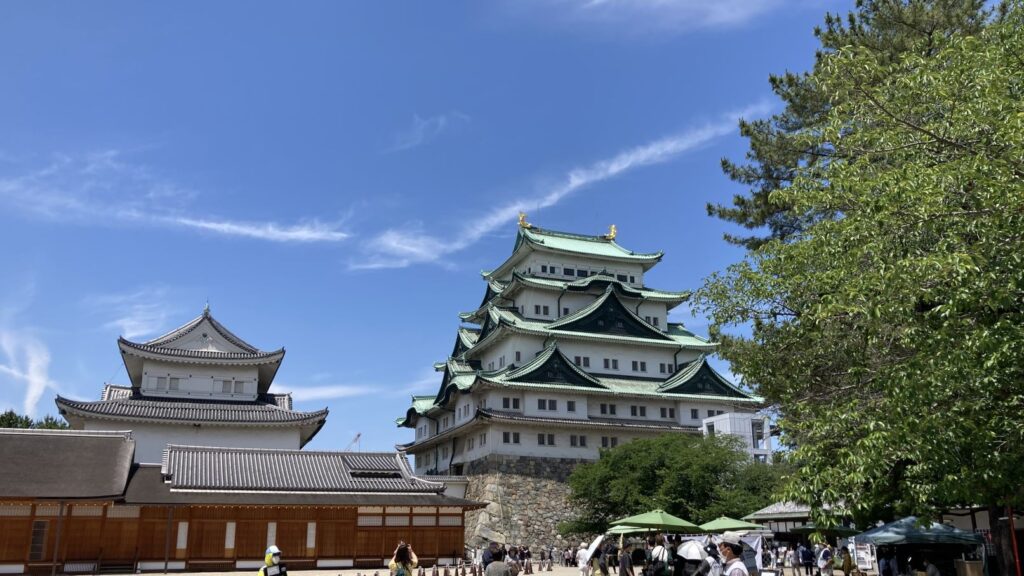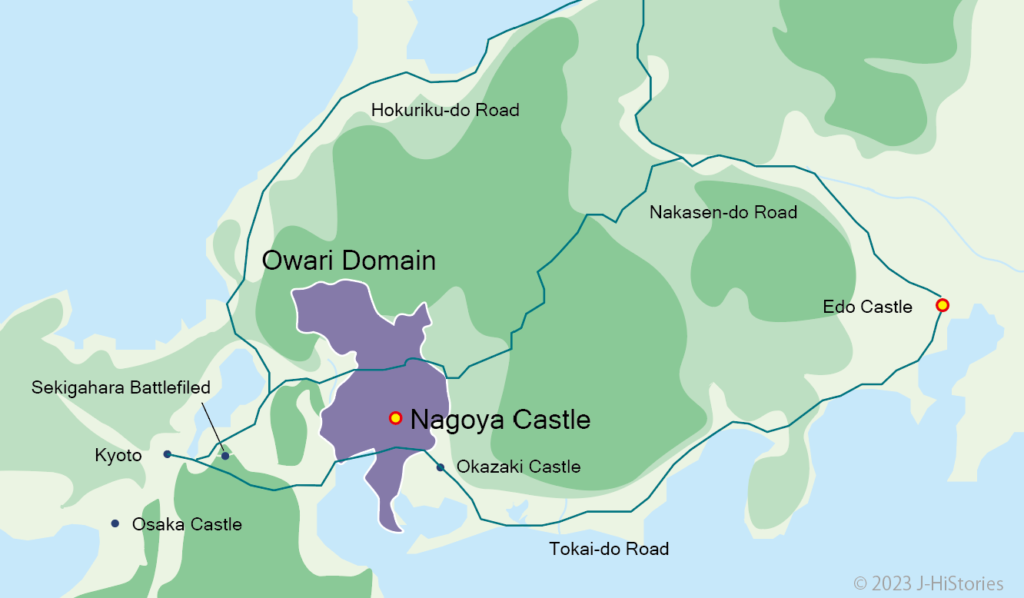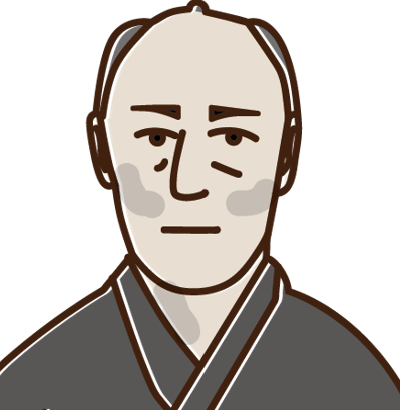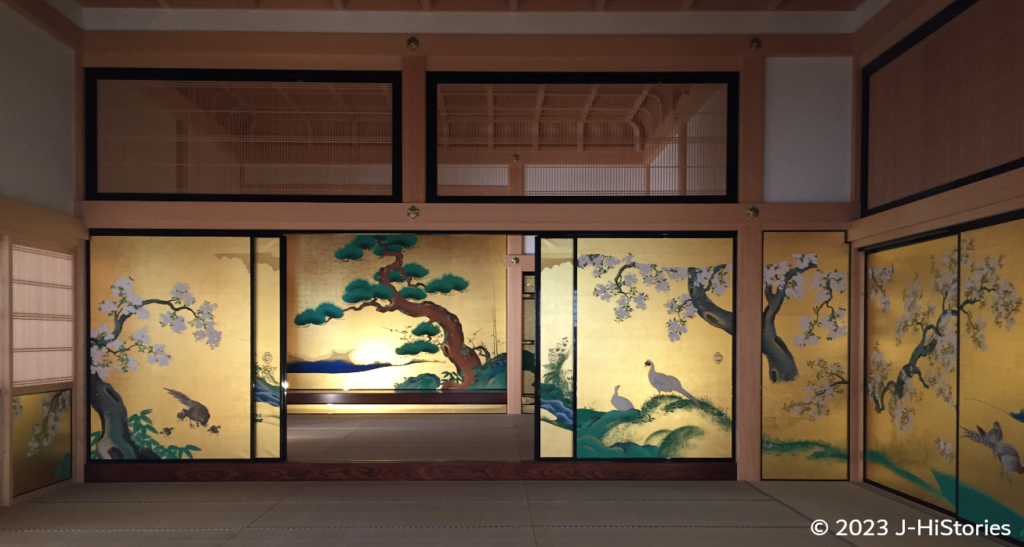Why was Nagoya Castle built? For the iron defense of the Tokugawa Shogunate
Nagoya Castle was built by a warlord, Tokugawa Ieyasu, as a solid fortress in 1612, just two years before the Winter Siege of Osaka against the Toyotomi clan. After Ieyasu's victory, Nagoya Castle kept the Western lords in check in the middle of the Tokaido road connecting Edo (Tokyo) and Osaka. He was eager to realize a peaceful nation without any battles anymore. Around 200 years later, however, the last lord of Owari Tokugawa domain, Tokugawa Yoshikatsu, let the Imperial army, which was eager to defeat Tokugawa’s Edo Castle, marched into Edo unchallenged. Consequently, the Tokugawa Shogunate ended in 1868. Why did Yoshikatsu not protect the Tokugawa Shogunate, even though he lived in the strongly defended Nagoya Castle? What was the reason for such a decision?

Ironclad defense against warlords to end the Warring turmoil
Under the still unsettling warring state, Tokugawa Ieyasu (1543-1616, 徳川家康) at age 71 better prepared to defeat the Toyotomi Hideyoshi’s heir, Hideyori in Osaka Castle and Hideyoshi's retainers mainly in western regions. He put Nagoya Castle as a wedge between Osaka and Edo on the arterial Tokaido road. Furthermore, he built several castles surrounding Osaka Castle one by one, such as Hikone Castle on the eastern shore of Lake Biwa. He ordered his 9th son, Tokugawa Yoshinao (1601-1650, 徳川義直) as the Lord of Tokugawa Owari Domain in Nagoya. The Owari Tokugawa covered a large amount of territory, which was strategically important; the current Aichi, Gifu, Nagano, and partially Shiga prefectures with strong military power and financial base as the head of Gosanke (three high-ranking Tokugawa families) following Tokugawa head family. Ushered in the antechamber of Nagoya Castle, the guests of lords felt the Tokugawa's immense power by tiger paintings that were about to attack them. Well prepared, in 1614, the siege of Osaka began and the Toyotomi clan ended. The following year, Ieyasu closed the curtain of his long life, which was devoted to realizing a peaceful nation. Nagoya Castle was the keystone for his ambition of realizing a peaceful nation. But, the last lord of the Owari domain, Tokugawa Yoshikatsu (1824-1883, 徳川義勝) let the Imperial Army march into Edo without fighting so that the 260-year-long Tokugawa Shogunate ended.

Yoshikatsu reformed the domain but was punished by the Chief Minister, Ii Naosuke

Around 200 years later, Tokugawa Yoshikatsu became the legitimate 14th lord of the Owari Tokugawa domain in 1849 at the age of 25. He started to reform its domain duties such as (1) fiscal reconstruction, (2) appointment of talented people, and (3) enhancement of the coastal defense. As a result, its financial situation improved rapidly. Facing the US Commodore Perry's request to open the country, a chief minister of the Tokugawa Shogunate, Ii Naosuke (1815-1860, 井伊直弼) signed two treaties and opened several ports starting at Shimoda without an imperial sanction. This caused various criticisms and conflicts between the Imperial court and the Tokugawa Shogunate because the 121st Emperor Komei (1831-1867, 孝明天皇) raised difficulties over the Shogunate about the treaty without imperial sanction. Yoshikatsu also visited Edo castle with another lord of the Mito domain and criticized Ii. A month later, Yoshikatsu was ordered to be confined at the home by Ii and he went through dark days and years.
Yoshikatsu regained the front stage to restore relations between the Imperial Court and the Shogunate
In 1860, he was suddenly allowed to leave the house arrest due to the assassination of Ii in front of the Sakurada Gate of the Edo Castle. From then on, Yoshikatsu joined the political mainstream and devoted himself to the unification of the Imperial Court and the Shogunate under the chaotic situation of a series of radical incidents, assassinations, and conspiracies, mainly in Kyoto among various groups such as the open country wing or the expulsionists and the direct administration by the emperor or the Shogun.
Finally, the Kinmon incident occurred in front of the Kyoto Imperial Palace about one month after the Ikedaya incident. Some radical, loyal, antiforeigner low-ranking samurai in the Choshu domain stepped up their fight and dared to fire their guns in the direction of the Kyoto Imperial Palace. Yoshikatsu was designated the general of the Tokugawa army for the conquest of Choshu under the Imperial order. It was unusual to experience domestic conflicts at that time, considering the fear of foreign countries’ invasions. Therefore, he tried and succeeded with a soft approach to avert an all-out war. After that, he continued to work hard to mediate between the imperial court and the Shogunate. However, it was getting very explosive and he was forced to make a tough decision about one year later.
The anti-Shogunate faction started attacking the Shogunate with intrigue and force
Choshu regained its strength by once again collaborating with a few radical low-ranking court nobles like Iwakura Tomomi (1825-1883, 岩倉具視). During the upheavals of the last Edo period, the 15th Shogun, Tokugawa Yoshinobu (1837-1913, 徳川慶喜) electrifyingly returned political power to the emperor in 1867. It was said to be his strategic tactic to maintain a key role in a new administration under the emperor. However, the anti-Tokugawa group decided to defeat the Tokugawa Shogunate by force. The following year, the Battle of Toba-Fushimi occurred in Kyoto between the Tokugawa military and the Imperial army (main forces from the Choshu and Satsuma domains). Soon after, the Tokugawa warriors were routed to Edo where Edo Castle was located to avoid becoming an enemy of the emperor.
Yoshikatsu’s tough decision; “Follow Emperor’s order as a retainer of Emperor”
The next threat to the Imperial Army was the Owari domain’s massive military power. Therefore, Iwakura sent a peremptory message to Yoshikatsu to force a decision on which side the Owari domain should take, either Tokugawa or the Emperor. As it was issued as an order from the Imperial Court, Yoshikatsu had no option but to comply with it. Yoshikatsu took a decisive step to take the Imperial side under the burden of Tokugawa’s highest-ranking family. He sent his letter to approximately 600 Tokugawa feudal lords in his own Owari domain along the thoroughfare of the Tokaido, Nakasendo, and Hokurikudo roads connecting Kyoto and Edo to let the Imperial army march into Edo unchallenged. This led to the bloodless surrender of Edo Castle in 1868. On this, Yoshikatsu negotiated with Saigo Takamori, the Imperial Army staff officer, to capture the role of receiving the Edo castle peacefully. This would be Yoshikatsu's sense of pride as a Tokugawa member. Although we are uncertain about Yoshikatsu's exact thoughts, it is possible that his difficult decision, as the head of the Owari Tokugawa domain and the highest-ranking family of the Tokugawa clan after the head family, was influenced by the commandment of Yoshinao, the first lord of Owari Tokugawa: “Follow the Emperor’s order as a retainer of the Emperor (王命に依って催さるる事)”. After that, Yoshikatsu made efforts to petition to save his cousin, Tokugawa Yoshinobu, the 15th Shogun.
The tragedy of Yoshikatsu's brother, Katamori, Lord of the Aizu Domain
After the Imperial Amy reached Edo without any chance to fight. They subsequently demanded an outlet to relieve their energy to fight to attack the Tsurugajo Castle of the Aizu domain in Fukushima prefecture fiercely as their enemy. Aizu was decimated, although Aizu federal load, Matsudaira Katamori(1836-1893, 松平容保) as Yoshikatsu’s brother vowed allegiance to the Imperial court. Yoshikatsu, for the rest of his life, kept one picture of the wretched Tsrugajo Castle of the Aizu domain, which got pounded by the Imperial army. The Imperial Army continued to move northward and fought against the remaining former Tokugawa warriors at Goryokaku in Hakodate. Here, the Boshin War, which lasted nearly two years, ended in 1869. In 1878, Yoshikatsu and Katamori met and ate together, though we don’t know what they talked about.
Can’t miss the overwhelming beauty of 1,049 sliding door paintings with gold foil
Please enjoy the renovated Nagoya Castle to think of Owari’s position as the first of the three Tokugawa high-ranking families, and Yoshikatsu’s anguish but bold decision beyond one federal lord but his deep deliberation about Japan’s future. 1049 paintings from the walls and sliding doors in the Hommaru Palace were created by the great Kano School painters such as Kano Tanyu (1602-1674, 狩野探幽), and were specified as important cultural properties. These paintings were authentically restored in 2018.

Tokugawa Yoshikatsu Timeline
| 1603 | Tokugawa Ieyasu established Tokugawa Shogunate at Edo | - | Edo Period |
| 1824 | Tokugawa Yoshikatu was born | Age=1 | |
| 1837 | Tokugawa Yoshinobu (later the 15th Shogun) was born in the Mito domain | 14 | |
| 1849 | Yoshikatsu was appointed the lord of Owari Tokugawa Domein | 25 | |
| 1854/3 | The Treaty of Peace and Amity between the US and Japan was concluded | 30 | |
| 06/19 | The Treaty of Amity and Commerce between the United States and Japan was concluded without an imperial sanction in 1858 | 30 | |
| 06/23 | Three major federal lords entered Edo castle without the permission in advance | 30 | |
| 1858/09- | Ansei Purge started to crackdown on over 100 people including Yohinobu's father | 34 | |
| 1860/03/03 | Ii Naosuke was assassinated in front of Sakuradamon gate | 36 | |
| 1862 | Yoshikatsu was released from his house of confinement | 38 | |
| 1863 | Yoshikatsu handed over the lord of Owari to his son and supported him | 39 | |
| /5 | Choshu bombarded the Western fleets (Shimonoseki War) | 39 | |
| /8 | Anglo-Satsuma War | 39 | |
| 1864/08 | Kinmon incident, Yoshinobu fought and protected the Kyoto Palace | 40 | |
| 1864/08 | “The Choshu Conquest -1” was issued by the cabinet officials of the shogunate. Yoshikatsu went to the front as the Senior Staff | 40 | |
| 1866/03 | The political and military alliance concluded between Satsuma and Chōshū domains | 42 | |
| 1866/07 | “The Choshu Conquest -2” was issued by the cabinet officials of the shogunate. Yoshikatsu opposed the reconquest. | 42 | |
| 1867/1 | Tokugawa Yoshinobu was appointed the 15th Shogun | 43 | |
| 1867/01 | Emperor Komei passed away | 43 | |
| 1867/11/10 | Taisei Hokan, Tokugawa's political power was officially returned to Emperor Meiji | 43 | |
| 1867/12/5 | The Decree for the Restoration of Imperial Rule | 43 | |
| 1868/1/3 | The Boshin War started at Toba-Fushimi | 44 | |
| 1868/1/20 | Aobamatsu Incident: Yoshikatsu purged supporters of the shogunate | 44 | |
| 1868/1 | Yoshikatsu ordered his lords to let the Imperial army march into Edo unchallenged | 44 | |
| 1868/4/11 | Edo castle surrendered without bloodshed to Imperial Army | 44 | |
| 1868/9 | Aizu War ended | 44 | |
| 1868/10/23 | The Meiji Restoration | 44 | Meiji Era |
| 1869/5/18 | Boshin War ended at Hakodate | 45 | |
| 1883 | Tokugawa Yoshikatsu passed away | 60 |

